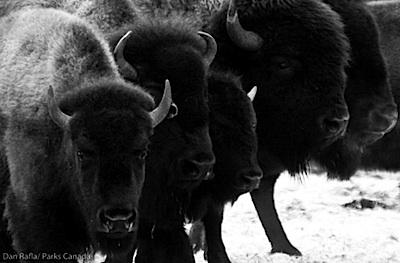
A plan has been approved to bring plains bison back to some areas of Banff National Park in Alberta/Parks Canada, Dan Rafla.
Plains bison, an icon of wild landscapes, will be returned to Banff National Park in Alberta, Canada, in an effort to bring the "missing link" back to the park's wildlife ecosystem.
The decision, announced last week, will both support Canada's National Conservation Plan and also bring a better balance to the park's ecosystem.
Historically, bison played a key role in the ecosystem and were a dominant herbivore in the area of what is now Banff National Park. Through their grazing and physical disturbance of vegetation and soil, bison helped create and maintain the patchwork of meadows, grasslands and other open habitats upon which they, and many other animals and plants, depend. Bison were also a food source for predators and scavengers. Similarly, decomposing bison carcasses provided a flush of nutrients for soil microorganisms and plants. Reintroducing bison is an important step toward restoring the full diversity of species and natural processes to Banff's ecosystem, and to delivering on a core element of Parks Canada's mandate.
While bison were native to the landscape included in Banff National Park today, hunting had removed them from the area before the park was created in 1885, according to Parks Canada.
The return of bison to Banff won't happen overnight. Parks Canada is working off a 5- to 6-year, $6.4 million plan that will involve a "soft release" approach that will start in year three with bringing 30-50 plains bison (all certified free of brucellosis and bovine tuberculosis) from Elk Island National Park to a pen in the backcountry of Banff National Park's Panther River Valley. The gate to the pen will be left open early in the spring of the fourth year to allow the bison to roam into the valley on their own. They eventually might be allowed to move into the Red Deer and/or Cascade River valleys.
As part of the recovery project, Parks Canada will invite First Nations members to share traditional knowledge of plains bison, and participate in stewardship, management and celebrations and will engage students and volunteers to participate in bison research, monitoring and stewardship activities.
'Our Government is taking action to protect our rich natural heritage for all Canadians now and in the future. Successfully restoring this keystone species in Banff will allow visitors, neighbours and the public at large to experience an authentic national park experience," said Blake Richards, Member of Parliament for Wild Rose.



Comments
Hope it doesn't result in this ;)
http://www.dailymail.co.uk/travel/travel_news/article-2978908/Road-hog-T...